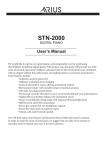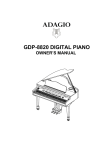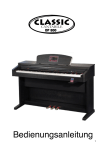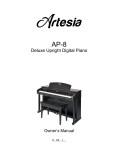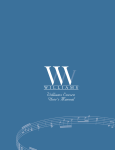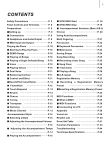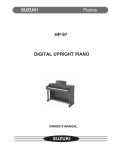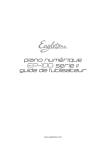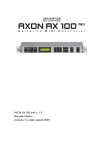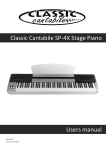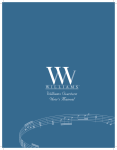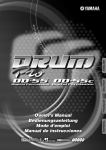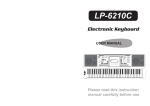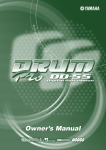Download Williams Symphony Owner`s manual
Transcript
Important Safety Instructions 1) Do not use near water. 2) Clean only with dry cloth. 3) Do not block any ventilation openings. 4) D o not place near any heat sources such as radiators, heat registers, stoves, or any other apparatus (including amplifiers) that produce heat. 5) Do not remove the polarized or grounding-type plug. 6) Protect the power cord from being walked on or pinched. 7) Only use the included attachments/accessories. 8) Unplug this apparatus during lightning storms or when unused for a long period of time. 9) R efer all servicing to qualified service personnel. Servicing is required when the apparatus has been damaged in any way, such as power-supply cord or plug is damaged, liquid has been spilled or objects have fallen into the apparatus, the apparatus has been exposed to rain or moisture, does not operate normally, or has been dropped. FCC Statements FCC Statements 1. Caution: Changes or modifications to this unit not expressly approved by the party responsible for compliance could void the user’s authority to operate the equipment. 2. Note: This equipment has been tested and found to comply with the limits for a Class B digital device, pursuant to Part 15 of the FCC Rules. These limits are designed to provide reasonable protection against harmful interference in a residential installation. This equipment generates, uses, and can radiate radio frequency energy and, if not installed and used in accordance with the instructions, may cause harmful interference to radio communications. However, there is no guarantee that interference will not occur in a particular installation. If this equipment does cause harmful interference to radio or television reception, which can be determined by turning the equipment off and on, the user is encouraged to try to correct the interference by one or more of the following measures: • Reorient or relocate the receiving antenna. • Increase the separation between the equipment and receiver. • Connect the equipment into an outlet on a circuit different from that to which the receiver is connected. • Consult the dealer or an experienced radio/TV technician for help. 1 We would like to express our appreciation, and congratulate you for purchasing this Williams Symphony digital piano. With proper care, this piano will provide you with years of musical enjoyment. Williams’ advanced state of the art electronics are combined with an elegant cabinet that adds beauty and sophistication to any home environment. Some features include: • Authentic acoustic piano feel • Williams’ acclaimed stereo imaging • Acoustic instrument voices offering unmatched realism • Metronome feature with variable tempo to facilitate practice • 100 Auto-Accompaniment Styles • Three track recorder that allows you to record and playback your performances • Digital effects to further enhance the instrument voices • 50 pre-recorded play-along songs with separate left hand/right hand • MIDI In/Out and USB Connections • Stereo line output and two headphone outputs • Stereo line input and microphone input • Sustain, soft, and Sostenuto pedals You will find many more features and functions listed within this owner’s manual. In order to make the most of your piano, we suggest that you take a few minutes to read this owner’s manual, then save it for later reference. 2 Contents Taking Care of your Digital Piano Connector Panel Pedals Panel Controls Keyboard Voices Voice Selection Layer (Dual) Voice Lower (Split) Voice Rhythm Styles Style Selection Auto-Accompaniment Auto-Accompaniment Split Point Auto-Accompaniment Chord Fingering Using the Auto-Accompaniment Auto Harmony Adjusting the Tempo Metronome Functions Reverb Level Setting Chorus Level Setting Touch Response Setting Changing the Split Point for Lower Voice Changing the Split Point for Auto Accompaniment Auto Harmony Type Selection Master Tune Drum Kit Selection (Keyboard Percussion) Registration Memory Save Registration Recall Registration Recorder Recording Playback Erasing Tracks Play-Along Songs MIDI MIDI Implementation Chart Voice List Style List Chord Fingering Guide Drum Kit List Specifications Warranty Information 4 5 6 7 14 14 15 16 17 17 18 18 18 19 20 21 21 22 22 23 23 24 24 25 25 26 27 27 27 28 28 30 30 31 33 34 35 38 39 40 43 44 3 Taking Care of Your Digital Piano This Williams Symphony digital piano will supply you with years of musical enjoyment if you follow the suggestions listed below. Service and Modification This product should be serviced by qualified service personnel when: • The power supply cord or the plug has been damaged. • Liquid has been spattered into the unit or it has been exposed to rain. • The instrument does not appear to operate normally or exhibits a marked change in performance. • The instrument has been dropped or the cabinet has been damaged. Handling and Transport • Never apply excessive force to the controls, connectors or other parts of the instrument. • Always unplug cables by gripping the plug firmly, not by pulling on the cable. • Disconnect all cables before moving the instrument. •Physical shocks caused by dropping, bumping, or placing heavy objects on the instrument can result in scratches and/or more serious damage. •Carefully check the amplifier volume control before playing. Excessive volume can cause permanent hearing loss. Cleaning •Clean the cabinet and panel with a soft, dry cloth. A wax based polish may be used on the cabinet, although rubbing with a soft cloth will usually suffice. Do not use paint thinner or petrochemical based polishes. •To maintain the luster of the keys and buttons wipe with a clean, lightly dampened cloth, and then polish with a soft, dry cloth. Location • To avoid deformation, discoloration, or more serious damage, do not expose the instrument to the following conditions: Direct sunlight, high temperatures, excessive humidity, excessive dust, strong vibration. • Leave enough space around the piano for proper ventilation. •This instrument contains digital circuitry and may cause interference if placed too close to radio or television receivers. If interference occurs, move the instrument further away from the affected equipment. • Avoid placing vinyl objects on top of the instrument, vinyl can stick to and discolor the surface. Power • Turn the power switch off when the instrument is not in use. •T o avoid damage to the instrument and other devices to which it is connected, turn the power switches of all related devices off prior to connecting or disconnecting MIDI cables. • Turn the power off if the main cable is damaged, or the instrument is spattered with liquid. •Do not switch the unit on and off in quick succession, this places an undue load on the electronic components. • Unplug the AC power cord during an electrical storm. •Avoid plugging the AC adaptor into the same AC outlet as appliances with high power consumption, such as electric heaters or ovens. 4 Connector Panel This connector panel, with its various jacks, is located underneath the keybed. 1 2 3 4 5 6 1. MICROPHONE: Plugging in a microphone will allow you to sing along while you play piano. 2. PHONE 1 / PHONE 2: You can play in total silence without disturbing others by plugging a set of headphones into one of the appropriate sockets. When headphones are plugged into either of these jacks the main speaker system is turned off. Two sets of headphones may be used simultaneously. 3. LINE IN: These stereo audio input jacks will amplify the supplied signal through the internal sound delivery system. They can be used to hook up items such as CD players, MP3 player or cassette players. 4. LINE OUT: These stereo audio output jacks supply the piano’s output signal to external amplification devices such as home stereo, PA system, or other stand alone amplifiers. 5. MIDI IN / MIDI OUT: The Symphony provides MIDI IN and MIDI OUT ports. MIDI allows communication with other products equipped with MIDI interfaces. Please see the MIDI section of this manual for further details. 6. USB: The USB connector allows you to connect the Symphony piano directly to your computer. It can be connected without driver installation under the Windows XP & MAC OSX environment. The Symphony will be recognized as USB Audio device to receive and transmit MIDI messages. 5 Pedals Soft Sostenuto Sustain Soft Pedal When the left pedal is engaged the piano volume is reduced and the timbre slightly altered on the notes that are played. Sostenuto Pedal When the center pedal is engaged, the keys that were already held down will continue to sustain and the notes will decay gradually after they are released. Other keys that are played after the pedal has been pressed are not affected. Sustain Pedal When the right pedal is engaged the piano keys will continue to sustain as they are played. The piano notes will decay gradually as if you were continuing to hold down the piano keys. 6 Panel Controls The control panel is divided into several distinct sections. The following is a brief description of all the features located on the control panel. 1 4 5 6 3 2 1. MASTER VOLUME: Use this sliding control button to adjust the overall volume of the keyboard. 2. ACCOMPANIMENT VOLUME: Slide this controller to adjust the volume of the auto accompaniment only, the keyboard instrument voice will not be affected. It also controls the Metronome volume level. 3. TEMPO: Press one of the TEMPO buttons, the current tempo value will appear on the display. You can use the TEMPO +, TEMPO – buttons to change the tempo value range from 40 to 240 bpm (beats per minute). Press the TEMPO + or TEMPO – buttons simultaneously to recall the default tempo setting for the selected rhythm style. After three seconds the display will revert to the selected voice. NOTE: There is a four-dot beat indicator above the tempo buttons. It indicates the accompaniment tempo and beat. 4. HARMONY: When selected, a single note played on the right-hand section of the keyboard will activate additional auto harmony notes when the auto accompaniment is engaged. The harmony type selection is assigned in the Function menu. 5. LAYER: Engaging the LAYER button places the keyboard in the layer mode. Layer, or dual, refers to an additional voice that is “tone mixed” with the selected keyboard voice. The assigned layer voice will be heard with the original voice. To select a new layered instrument voice, use the +YES or -NO buttons within 4 seconds after the LAYER button has been engaged. 6. LOWER: With the Lower feature engaged, the keyboard operates in the “split” mode. In the Lower mode, the keyboard is divided into two sections. In the right-hand section, the original or layered voice will sound, and in the left-hand section a different voice can be assigned to sound when the keys are played. To select a new Lower instrument voice, use the +YES or -NO buttons within 4 seconds after the LOWER button has been engaged. 7 7 8 9 10 11 12 7. SYNC START: Synchronized Start sets the auto accompaniment into standby mode. When the SYNC START button is pressed, the four indicator LEDs above the Tempo buttons will flash to the tempo of the selected rhythm style. The rhythm style will start as soon as you play in the auto accompaniment section of the keyboard. The auto accompaniment will start with the first recognized chord played in the auto accompaniment section of the keyboard, depending on which fingering mode is selected. 8. START/STOP: This button starts or stops the selected rhythm style. The auto accompaniment will start with the first recognized chord played in the auto accompaniment section of the keyboard, depending on the fingering mode selected. 9. INTRO/ENDING: The 100 rhythm styles can be started or finished with an individual introduction or ending pattern. When Intro/Ending is engaged, an introductory rhythm pattern will start followed by the main pattern. With a rhythm or accompaniment pattern already engaged, the accompaniment can be completed with an ending pattern from the next measure by pressing the INTRO/ENDING button. 10. FILL IN: The fill-in provides the accompaniment with a short rhythm pattern of one or two measures for each style. To add a fill-in, press the FILL IN button at any time while the accompaniment is playing. 11. VARIATION: The 100 rhythm styles include a style variation that can be played simply by engaging the VARIATION button. Press the VARIATION button again to return to the main pattern. 12. ACCOMPANIMENT: Each rhythm style has fully orchestrated auto accompaniment patterns. These accompaniments are dedicated to the selected rhythm style, and will create drums, bass and chord accompaniments. The ACCOMPANIMENT button selects the auto accompaniment mode. The auto accompaniment fingering modes are single, fingered, piano, and off. Press the ACCOMPANIMENT button until the indicator LED turns on. 8 13 15 14 16 13. QUICK SELECT VOICE BUTTONS Each Voice button controls two voices, one in the A bank (printed above the voice button) and one in the B bank (printed below the voice button) for a total of 10 Quick Select voices (8 Presets and 2 User-defined). Please see the Keyboard Voices section of this manual for more information. 14. QUICK SELECT STYLE BUTTONS Each Style button controls two styles, one in the A bank (printed above the style button) and one in the B bank (printed below the style button) for a total of 10 Quick Select styles (8 Presets and 2 User-defined). Please see the Rhythm Styles section of this manual for more information. 15. A/B BUTTON Press the A/B (Above/Below) to alternate between A and B banks for Voice or Style Quick Select. The A/B button indicator is lit when the B bank is selected. 16. METRONOME: Press the METRONOME button to engage the built-in metronome. Use the +YES and –NO buttons within three seconds after the metronome has been engaged to select the beat of your choice: 1/4, 2/4, 3/4, 4/4, 5/4, 6/4, 6/8 or 12/8. 9 17 18 19 17. VOICE: There are 128 GM (General MIDI) instrument voices, plus ten Asian folk instrument voices available on this piano. You can instantly select an instrument voice by pressing one of the voice select buttons. Or, when the voice button is engaged, you can use the number pads to select a voice. The voice name and its number will be shown on the display. There is a complete list of all 138 voices listed in the back of the manual. Please see the Voice section for more information. 18. STYLE: To engage one of the 100 rhythm styles and the corresponding auto accompaniment, press one of the rhythm style buttons or press the STYLE button to engage the style selection mode. While its indicator LED is lit, use the number pads to select a style. The style name and its number will be shown on the display. There is a complete list of all 100 rhythm accompaniment styles listed in the back of the manual. Please see the Rhythm section of this manual for more information. 19. SONG: This “music teacher” feature can be used as a learning aid to the 50 songs built into this piano. The SONG button turns the music teacher function on and off. Please see the Play-Along Songs section of this manual for more information. 10 20 21 22 23 20. FUNCTION: The FUNCTION button is used to access the function menu. The function menu can be used to adjust or change the parameters of a number of settings: reverb level, chorus level, touch, split point for voice, auto accompaniment split point, tuning, drum kit selection and the auto harmony type. Please see the Function section of this manual for more information. 21. PAGE: The PAGE buttons (up and down) are used to access the different menus in the Function feature. When the FUNCTION button has been pressed, use the PAGE UP and PAGE DOWN buttons to access the Function menu selections. 22. USER REG: Registration is used to store keyboard settings. Press the USER REG button to engage the registration memory mode. Press one of the numeric buttons 1-9 and the stored setting will be recalled instantly. Please see the Registration Memory section of the manual for more information. 23. NUMERIC PAD: Use the +/YES, –/NO or the numeric pad to input numbers directly while using the voice, style or function settings. These buttons are also used to access or alter many of the function features or wherever numerical input is necessary. 11 24 25 26 27 24. TRANSPOSE: The transpose feature can shift the pitch of the keyboard up or down in semitone intervals up to a maximum of 24 semitones. Press one of the TRANSPOSE buttons and the current transpose value will appear on the display. Use the TRANSPOSE + or TRANSPOSE – buttons to set the transpose value range from –12, one octave lower, to 12, one octave higher. Press the + and – value buttons simultaneously to recall the default value of 0. After three seconds the display will return to the currently selected instrument voice. Transpose does not affect notes that are currently playing. Transpose does not affect the keyboard percussion. 25. REVERB: Reverb simulates the effect of playing in a big room or hall where the sound reverberates off the walls and ceiling. The reverb effect is engaged automatically when the power is turned on. Press the REVERB button to turn off the reverb effect. You can switch the reverb feature on and off by pressing the REVERB button. The reverb setting does not affect the auto accompaniment. Reverb depth can be changed in the Reverb Level function menu. Please see the Function Section for more information. 26. CHORUS: The Chorus effect adds depth and spaciousness to the selected keyboard voice. Press the CHORUS button to engage the chorus effect and the indicator will light up. Press the button again to turn off the chorus effect. The chorus setting does not affect the auto accompaniment. Chorus depth can be changed in the Chorus Level function menu. Please see the Function Section for more information. 27. SONG LEFT , SONG RIGHT: These buttons are used in conjunction with the SONG button. It allows the player to play along with the prerecorded songs contained within this piano. The SONG LEFT button will play the right hand of the selected song, so that the user can practice the left hand portion of the song. The SONG RIGHT button will play the left hand of the selected song, so that the user can practice the right hand portion of the song. When engaging the SONG LEFT and SONG RIGHT buttons simultaneously only the rhythm part (if available) will be heard. The user can now play both the left and right portions of the selected song. Please see the Play-Along Song section of this manual for more information. 12 28 29 30 31 32 33 28. USER SONG: The Symphony is able to record four songs, each with a 3-track sequencer. It will record all note events and the accompaniment patterns exactly as they are performed. This recorded information will not be lost when the power is turned off. The USER SONG button accesses one of the four available user songs settings for recording or playback. Please see the Recorder section of this manual for more information. 29. ACCOMPANIMENT TRACK: The ACCOMP button is used to select the auto accompaniment track of a song for recording or playback. Please see the Record section of this manual for more information. 30. MELODY TRACKS: There are two tracks for recording melody, which are assigned by the MELODY 1 and MELODY 2 buttons. Please see the Record section of this manual for more information. 31. RECORD: To prepare for recording, hold down the REC button and press the track button(s) you want to record in. Please see the Record section of the manual for more information. 32. PLAY/STOP: Press the PLAY/STOP button to hear selected tracks that you have recorded. Press the PLAY/STOP button again to stop the playback. Please see the Recorder section of this manual for more information. 33. DEMO: The Symphony has ten different demonstration songs. Press the DEMO button. The first demo song will play back instantly. To access an individual demo song press the +/YES or –/NO buttons when the Demo Feature is engaged. All songs will play repeatedly until you press the DEMO button again to stop the song demonstration. 13 Keyboard Voices The Symphony offers 128 GM voices in 16 groups plus 10 Asian ethnic folk instrument voices. A complete list of all 138 voices can be found in the back of this manual. Voice Selection SELECTING ONE OF THE 138 VOICES 1. If the Voice mode indicator is not already lit, press the VOICE button to engage the voice selection mode. The indicator will light up. 2. Use the numeric pad or the +/YES, –/NO buttons to select a voice number. The voice name and its number will be shown on the display. NOTE: When using the number pads, you must enter three digits to select a voice number from 001-138. For example, to select voice No. 2 you must enter “002”. Please refer to the back of the manual for a list of all available voices. QUICK SELECT Each Voice button controls two voices, one in the A bank (printed above the voice button) and one in the B bank (printed below the voice button) for a total of 10 Quick Select voices (8 Presets and 2 User-defined). To recall a Quick Select voice: 1. Press the A/B (Above/Below) button to select a bank. Selection alternates between A and B banks every time the A/B button is pressed. The A/B button is lit when the B bank is selected. 2. N ow press one of the five Quick Select voice buttons to select the desired voice. The voice name and number will be shown on the display. USER DEFINED QUICK SELECT BUTTON - VOICE You can assign your 2 favorite voices to the voice Quick Select button in the following manner: 1. Press the voice USER button (selects USER 1 for bank A, or USER 2 for bank B). 2. Select the desired voice by using the numeric pad or the +/YES, –/NO buttons. 3. Press another Quick Select voice button. 4. The last selected voice will be assigned to the USER button to be available for quick selection. NOTE: The USER button will revert to the default setting when the power is turned off. (USER 1=012: Vibraphone, USER 2=092: Choir Pad) 14 Layer (Dual) Voice Layer, or dual, refers to an additional voice that is “tone mixed” with the originally selected keyboard voice. The assigned layer voice will be heard with the original voice when the layer feature is engaged. TO USE THE LAYER FUNCTION 1. Press the LAYER button, the currently assigned layer voice will be shown on the display, and the LED indicator will turn on. 2. Use the +/YES, –/NO buttons or the quick select voice buttons to select the desired Layer voice. NOTE: The LCD display will show the layer voice number and name, and after three seconds the display will revert to the originally selected main voice. Select the +/YES, –/NO buttons or the Quick Select Voice Buttons within the three second period that the layer voice is displayed 3. Press the LAYER button a second time and the current layer volume level will show on the display LCD. While the layer volume screen is displayed, use the +/YES or the –/NO buttons to raise or lower the volume of the selected layer instrument voice. The LCD display screen will show the volume setting. NOTE: This layer volume setting will be displayed on the LCD screen for three seconds. The LCD display will revert to the originally selected main instrument voice after three seconds. 4. Press the LAYER button again to turn the LAYER function off. 15 Lower (Split) Voice In the lower, or split, mode the keyboard is divided into two separate sections. To the right of the split point, the currently selected main voice, or the layered and main voice will sound. The keys to the left of the split point can play a different instrument voice. TO USE THE LOWER FUNCTION 1. Press the LOWER button, the currently assigned lower voice will be shown on the display, and the LED indicator will turn on. 2. Use the +/YES, –/NO buttons or the quick select voice buttons to select the desired lower voice. NOTE: The LCD display will show the lower voice number and name, and after three seconds the display will revert to the originally selected main voice. You must select the +/YES, –/NO buttons or the quick select voice buttons within the three second period that the lower voice is displayed. 3. Press the LOWER button a second time and the current lower volume level will show on the display LCD. While the lower volume is displayed, use the +/YES or the –/NO buttons to raise or lower the volume of the selected lower instrument voice. The LCD display screen will show the volume setting. NOTE: This lower volume setting will be displayed on the LCD screen for three seconds. The LCD display will revert to the originally selected main instrument voice after three seconds. 4. Press the LOWER button again to turn off the lower function. ASSIGNING THE SPLIT POINT FOR VOICE The keyboard is split into two sections at the split point. The default split point is the C3 key for voice. A different voice split point can be assigned in the Function menu “Split Point.” Please see the Function section of this manual for more information. 16 Rhythm Styles The Symphony offers 100 accompaniment rhythm styles to choose from. There is a complete list of all 100 styles in the back of this manual. Each rhythm style includes 6 patterns: introduction, main, fill-in x 2, variation and ending. In addition to the Drum part, the rhythm styles can provide a fully orchestrated accompaniment with bass, chords and additional instruments. Style Selection SELECTING ONE OF THE 100 STYLES 1. If the Style mode indicator is not already lit, press the STYLE button to engage the style selection mode. The indicator will light up. 2. Use the numeric pad or the +/YES, –/NO buttons to select a style number. The style name and its number will be shown on the display. NOTE: When using the number pads, you must enter two digits to select a style number from 00-99. For example, to select style No. 4 you must enter “04.” Please refer to the back of the manual for a list of all available styles. QUICK SELECT Each Style button controls two styles, one in the A bank (printed above the style button) and one in the B bank (printed below the style button) for a total of 10 Quick Select styles (8 Presets and 2 User-defined). To recall a Quick Select style: 1. Press the A/B (Above/Below) button to select a bank. Selection alternates between A and B banks every time the A/B button is pressed. The A/B button is lit when the B bank is selected. 2. N ow press one of the five Quick Select style buttons to select the desired rhythm. The style name and number will be shown on the display. USER DEFINED QUICK SELECTION BUTTON You can assign your two favorite rhythm styles to the style quick select button in the following manner: 1. Press the style USER button (selects USER 1 for bank A, or USER 2 for bank B). 2. Select the desired style by using the numeric pad or the +/YES, –/NO buttons. 3. Press another Quick Select style button 4. The last selected style will be assigned to the USER button to be available for quick selection. NOTE: The USER button will revert to the default setting when the power is turned off. (USER 1=82: Kids 1, USER 2=32: Folk 2) 17 Auto-Accompaniment In addition to the Drum part, the rhythm styles can provide a fully orchestrated accompaniment with bass and additional instruments, following the chords played on the keyboard. Auto-Accompaniment Split Point For auto-accompaniment, the keyboard is divided into two sections at the “Auto A.Split” point. The keys to the left of this point are defined as the accompaniment section of the keyboard. The default key for this point is G1. A different split point for the auto-accompaniment can be assigned in the Function menu. Please see the Function section of this manual for more information. Auto-Accompaniment Chord Fingering The Symphony has three auto-accompaniment chord fingering modes. Press the ACCOMP button until the indicator light for the desired Fingering mode is selected. When all three accompaniment mode indicators are off, the auto-accompaniment function is disengaged and only the Drum part of the rhythm styles will play. SINGLE MODE Single mode makes it easy to produce four types of orchestrated accompaniment chords using a minimum number of fingers (one, two, or three fingers at the most). In this mode, playing keys in the accompaniment section of the keyboard can generate: Major Chord: Press any key in the auto-accompaniment section of the keyboard. The key you press determines the root note of the major chord. Minor Chord: Press the root key and any black key to its left simultaneously. Seventh Chord: Press the root key and any white key to its left simultaneously. Minor-Seventh Chord: Press the root key and any pair of black and white keys to its left simultaneously. FINGERED MODE The fingered mode is ideal if you already know how to play chords on the keyboard. It allows you to play the chords in the auto-accompaniment section of the keyboard to produce the selected auto-accompaniment pattern. The Fingering Guide table at the back of this manual lists all of the 31 recognizable chords of this mode. NOTE: If a chord played cannot be recognized, the previous chord will keep playing. 18 PIANO MODE When the Piano chord fingering mode is engaged, you may enter chords anywhere on the keyboard. You are not limited to the auto-accompaniment section. In this mode, there is no keyboard split point function for chord recognition. MANUAL BASS CHORD When the Single or Fingered modes are engaged, you may play individual keys in the auto-accompaniment section of the keyboard. The voice on this section of the keyboard will be a layered bass and chord voice determined by the current style. This is a split voice mode, with the right hand playing the main voice. Using the Auto-Accompaniment Each rhythm style includes 6 patterns: an introduction, a main pattern and a variation pattern, two fill-ins and an ending. VARIATION Press the VARIATION button to toggle between the main and variation patterns. The indicator will light up when Variation is selected. There are several ways to start the rhythm style: STRAIGHT START Pressing the START/STOP button immediately starts the Drum part of main or variation pattern, depending on the status of the VARIATION button. If one of the chord fingering modes is engaged, the additional parts of the auto-accompaniment will start as soon as a chord is recognized, according to the selected chord fingering mode. STARTING WITH AN INTRODUCTION All of the 100 styles can be started with an introduction pattern. Pressing the INTRO/ENDING button immediately starts the Drum part of the introduction pattern, followed by either the main or variation pattern, depending on the status of the VARIATION button. If one of the chord fingering modes is engaged, the additional parts of the auto-accompaniment will start as soon as a chord is recognized, according to the selected chord fingering mode. 19 SYNCHRONIZED START Synchronized Start allows you to start the rhythm style by playing on the keyboard. Press the SYNC START button, all four beat indicator dots above the TEMPO buttons will blink at the preset tempo for the current style, showing that the synchronized start mode is on standby. The tempo can be adjusted while on standby, using the TEMPO +/- buttons. You may add an introduction by pressing the INTRO/ENDING button after pressing the SYNC START button. If any of the chord fingering modes is engaged, the complete auto-accompaniment will start as soon as a chord is recognized. If the Auto-accompaniment function is disengaged, only the Drum part of the rhythm style will start as soon as you play any key in the accompaniment section of the keyboard. FILL-IN Pressing the FILL-IN button will insert a short rhythmic pattern of one to two measures in length. Each style has two different fill-in patterns, depending on the status of the VARIATION button. Holding down the FILL-IN button will extend the fill indefinitely. NOTE: The FILL-IN button can also be used in place of the INTRO/ENDING button to start playing with a fill-in pattern instead of the introduction. STOPPING While a rhythm style is playing, press the START/STOP button to stop the accompaniment immediately, or press the INTRO/ENDING button to finish with an ending pattern. NOTE: If you want the selected rhythm style to continue after the ending pattern has been completed, press the FILL IN button while the ending pattern is playing. Auto Harmony With the Harmony feature engaged, a single note on the right-hand section of the keyboard will sound with additional auto harmony notes depending on the chords played in the accompaniment section of the keyboard. The note played in the right-hand section of the keyboard determines the root key of the harmony. It is recommended that only one note be played at a time. If more than one note is played only the highest note will add harmony. NOTE: Auto Harmony is only available when the auto-accompaniment is playing. Press the HARMONY button to turn the feature on and off. There are four harmony types that can be selected, duet, close harmony, open harmony, and octave. The harmony type selection is assigned in the Function menu. Please see the Function section for more information. 20 Adjusting the Tempo The four-dot indicator above the TEMPO buttons indicates the tempo and the beat for the accompaniment playing. Each style has its own preset tempo. The tempo can be adjusted before or during rhythm style play by pressing either of the TEMPO +/- buttons. The current tempo will be shown on the display for 3 seconds. During that time, you can also use the number pad to enter a new tempo value between 40 and 240. If you change the style before playing, the tempo will be set to that style’s default value. If you change style during play, the tempo will keep its current value. Press the TEMPO +/- buttons simultaneously to reset the tempo to the default value of the current style. Metronome The Symphony includes a built-in metronome. Press the METRONOME button to start the metronome. Its LED indicator will light up and the “Metronome” menu will appear on the display. Use the +/YES and –/NO buttons within three seconds after the metronome has been engaged to choose the beat pattern: 1/4, 2/4, 3/4, 4/4, 5/4, 6/4, 6/8 or 12/8. After three seconds, the display will revert to the selected Voice. Use the ACCOMP VOLUME slider to adjust the metronome level. Use the TEMPO +/- buttons to adjust the tempo of the metronome. The current tempo will be shown on the display for 3 seconds. During that time, you can also use the number pad to enter a new tempo value between 40 and 240. Press the METRONOME button again to stop the metronome. If you select a new accompaniment style or play a practice song, the beat and tempo of the metronome will be set automatically to the beat and tempo of that style/song. NOTE: If the metronome is enabled while the auto-accompaniment is playing, the metronome sound will replace the Drum part of the accompaniment style. 21 Functions The Function mode is used to set up or to adjust various parameters related to the operation of this keyboard. With the FUNCTION button engaged, you may access the menu for the Reverb level, Chorus level, Touch sensitivity, Lower Split point for voice, Split point for auto accompaniment, master tuning, the Drum Kit selection, and Harmony type selection. Reverb Level Setting Reverb simulates the effect of playing in a big room or hall where the sound reverberates off the walls and ceiling. The reverb effect is engaged automatically when the power is turned on. You can switch the reverb feature on and off by pressing the REVERB button. Select the level of reverb from the Function menu. 1. Press the FUNCTION button. 2. Press the PAGE UP or the PAGE DOWN buttons until the “Reverb Level” menu appears. 3. Press the +/YES button and the current reverb level will be shown. 4. Use the +/YES button to increase the reverb level or the –/NO buttons to decrease the level. The number pad can also be used to directly enter a value ranging from 01-16. Press the +/YES, –/NO buttons simultaneously to recover the default setting of 12. 5. Press the FUNCTION button again to exit the function setting mode. 22 Chorus Level Setting The Chorus effect enriches your selected instrument voice by adding depth and texture. Press the CHORUS button to engage the chorus effect. Adjust the level of chorus in the Function menu. 1. Press the FUNCTION button. 2. Press the PAGE UP or the PAGE DOWN buttons until the “Chorus Level” menu appears. 3. Press the +/YES button to confirm your selection and the current Chorus level will be shown. 4. Use the +/YES to increase the chorus level or the –/NO buttons to decrease the level. The number pad can also be used to directly enter a value ranging from 01-16. Press the +/YES, –/NO buttons simultaneously to recover the default setting of 08. 5. Press the FUNCTION button again to exit the function setting mode. Touch Response Setting The Symphony offers four types of keyboard touch sensitivity settings, soft, normal, hard, and fixed. These are also known as velocity settings and are designed to suit your style of playing. The Normal setting is selected automatically when the piano is turned on. The touch response can be changed with the function feature. Soft is the most sensitive keyboard response which permits maximum sound levels with a light touch. Normal is an intermediate response suitable for most styles of music. Normal is the default setting. Hard is a less sensitive keyboard response which requires a heavier touch to obtain maximum sound levels. Fixed does not offer any touch sensitivity. Each key plays at full volume no matter how hard the piano key is hit. It is commonly used on Harpsichord and Organ voices. 1. Press the FUNCTION button. 2. Press the PAGE UP or the PAGE DOWN buttons until the “Touch” menu appears. 3. Press the +/YES button to confirm your selection. The current touch response setting will be shown. 4. Use the +/YES, –/NO buttons to select a touch response. 5. Press the FUNCTION button again to exit the function setting mode. 23 Changing the Split Point for Lower Voice When the lower mode is engaged, the keyboard is divided into two parts at the split point. In the right-hand section the original or (Upper voice) will sound. In the left-hand section, a new instrument voice can be assigned. The split point for the Lower section can be changed in the Function menu. 1. Press the FUNCTION button. 2. Press the PAGE UP or the PAGE DOWN buttons until the “Split Point” menu appears. 3. Press the +/YES button to confirm your selection and the current voice split point will be shown. 4. Use the +/YES button to shift the split point up the keyboard to the right, and the –/NO button to shift the split point down the keyboard to the left, from G1–C7. Press the +/YES, –/NO buttons simultaneously to recover the default setting of C3. 5. Press the FUNCTION button again to exit the function setting mode. Changing the Split Point for Auto Accompaniment The split point that defines the accompaniment section of the keyboard can also be changed in the function menu. 1. Press the FUNCTION button. 2. Press the PAGE UP or the PAGE DOWN buttons until the “Auto A. Split” menu appears. 3. Press the +/YES button to confirm your selection and the current auto accompaniment split point will be shown. 4. Use the +/YES button to shift the split point up the keyboard to the right, and the –/NO button to shift the split point down the keyboard to the left, from AO–C3. Press the +/YES, –/NO buttons simultaneously to recover the default setting of G1. 5. Press the FUNCTION button again to exit the function setting mode. 24 Auto Harmony Type Selection When the HARMONY button is engaged, a single note on the right-hand section of the keyboard will be heard with additional auto harmony notes when the auto accompaniment is playing. There are four types of harmonies that can be selected. Duet adds a harmonizing note sounding below the single right-hand note that you supply when the chord accompaniment is playing. Close harmony adds two harmonizing notes sounding below the single right-hand melody note that you supply when the chord accompaniment is playing. Open harmony adds several harmonizing notes when the chord accompaniment is playing. Octave adds a note one octave below the note in the right-hand section of the keyboard when the chord accompaniment is playing. 1. Press the FUNCTION button, then the +/YES button to confirm. 2. Press the PAGE UP or the PAGE DOWN buttons until the “Harmony Type” menu appears. 3. Press the +/YES button to confirm your selection. The current harmony type will be shown. 4. Use the +/YES or –/NO buttons to select a harmony type. 5. Press the FUNCTION button again to exit the function setting mode. Master Tune The pitch of the Symphony is automatically set to standard A440 pitch when the piano is turned on. The tuning feature makes it possible to tune the pitch of the instrument in fine intervals. Tuning can be accomplished over a range of +/–1 semitone in +/–64 steps. 1. Press the FUNCTION button. 2. Press the PAGE UP or the PAGE DOWN buttons until the “Master Tune” menu appears. 3. Press the +/YES button to show the tuning value. 4. Use the +/YES button to increase the value or the –/NO buttons to decrease the value. Press the +/YES, –/NO buttons simultaneously to recover the default setting of 00. 5. Press the FUNCTION button again to exit the function setting mode. 25 Drum Kit Selection (Keyboard Percussion) In the Keyboard Percussion mode, the entire keyboard will play the percussion voices from the selected Drum Kit. There are ten drum kits that can be assigned. Kit 10 is a sound effects kit. Please see the “Drum Kit List” at the end of this manual for a complete listing. Select the Keyboard Percussion mode in the Function menu. 1. Press the FUNCTION button. 2. P ress the PAGE UP or the PAGE DOWN buttons until the “Drum Kit” menu appears. 3. Press the +/YES button to enter the Keyboard Percussion mode. 4. Use the +/YES, –/NO or number pad to select drum kit 01 to 10. NOTE: Pressing the -/NO key when KYBD PERC. 01 is selected will return the piano to regular Voice mode, and display the last selected voice. Pressing the +/YES key when KYBD PERC. 10 is selected will return the piano to regular Voice mode and display “Percussion OFF” until another kit is selected. 5. Press the FUNCTION button again to exit the function setting mode. If a kit is selected, the display will show “Percussion ON.” 6. Use the +/YES, –/NO or number pad to change drum kit 01 to 10. NOTE: Pressing the -/NO key when KYBD PERC. 01 is selected will return to regular Voice mode and display the last selected voice. Pressing the +/YES key when KYBD PERC. 10 is selected will return the piano to regular Voice mode and display “Percussion OFF.” If no other kit is selected within 3 seconds, the display will return to the last selected voice. 7. To quickly exit the Keyboard Percussion mode, press any one of the Quick Select Voice keys. 26 Registration Memory Registration Memory can recall particular settings of style, voice, chord and other parameters or features you have engaged. This piano has nine registration memories to hold your favorite settings so that they can be recalled quickly by pressing a button. The unit is equipped with a backup battery so your settings will not be lost when the power is turned off. Save Registration 1. Set the voice, style, tempo, accompaniment mode, reverb effect and any other parameters that you wish to save. 2. Hold down the USER REG button. 3. P ress one of the number pads 1-9. The display will show the current registration memory number with a “b-” prefix. Your panel setting will be saved into that registration memory button instantly. 4. Release the USER REG button. Recall Registration 1. Press and release the USER/REG button to engage the registration memory mode, the indicator will light up. 2. Press one of the number pads 1-9 buttons, the stored setting will be recalled instantly and the display will show the memory number with a “b-” prefix. The relevant parameters will be set and the display will revert to the voice that has just been recalled. 3. To exit the registration function mode, press the USER REG button again. Its LED indicator will turn off. 27 Recorder The Symphony features a three track recorder that allows you to record what you play on the keyboard and then play it back. Three tracks mean that you can “overdub” one part on top of another, using a different voice if you like. The recorder feature is a useful addition to any keyboard study program since it lets you hear exactly how you sound from the listener’s perspective. It can also be just plain fun. This recorder is able to store four songs, each with up to 3-track recording. This recorded information is nonvolatile and therefore will not be lost when the power is turned off. All 3 tracks can playback separately or together as a complete song. The record function records all settings exactly as you selected and performed them. NOTE: While it is possible to record in Layer mode, you cannot record in Lower mode. Recording 1. Prepare: Prepare to record by setting the voice, style, tempo, reverb level, or other parameters as desired. These settings can be stored into registration memory for easy recall; please see the Registration Memory section for more information. 2. Select a Song: Press the USER SONG button repeatedly to select a song. The LED display above the USER SONG button will show the song number selected. This is where the recorded information will be stored. 3. Select a track: There are three tracks available for recording: one dedicated Accompaniment track and two Melody tracks. The Accompaniment track will record only the auto accompaniment events and chords just as they are played. The Melody tracks will record all notes. The tracks are assigned by engaging the ACCOMP, MELODY 1 or MELODY 2 buttons. Press and hold down the REC button, then press the track button that you want to record in. The corresponding track indicator LED will blink, and the four beat indicators will blink with the current tempo to show that the recorder is on standby. NOTE: If you already have a recorded track in the selected song, the track indicator LED will also be lit and the recorded music will play as a reference for you while you record the new track. If you do not wish for previously recorded tracks to play while you are recording, press the corresponding track button to turn the indicator light off. 28 4. Metronome: Press the METRONOME button to enable the metronome as a reference when recording only Melody tracks. The metronome sound will not be recorded. NOTE: If you use the metronome when recording the Accompaniment track, the metronome will play in place of the drum part of the auto accompaniment. 5. Record: Your performance can be recorded in the following ways: RECORD A MELODY TRACK ONLY If the MELODY 1 or MELODY 2 buttons are selected, the recording will begin as soon as you play the keyboard or press the PLAY/STOP button. It is suggested you turn off the accompaniment fingering mode when recording on a melody track alone. When the accompaniment mode is set to Fingered or Single, the auto accompaniment section of the keyboard will not be recorded although the notes are sounding. Record the Accompaniment track only With the accompaniment fingering mode engaged, recording will start as soon as a chord is recognized in the auto accompaniment section of the keyboard. An unrecognized chord in the fingered mode cannot start the recording. If the accompaniment fingering is off, only the drum part will be recorded in the ACCOMP track. Recording will start as soon as you press the PLAY/STOP button or play in the accompaniment section of the keyboard. Notes played on the Melody section of the keyboard will not be recorded in the auto accompaniment track. Record the Accompaniment track and a Melody track If you want to record a melody and the accompaniment at the same time, hold down the REC button, press the ACCOMP track button and a MELODY track button. Both track indicators will blink. Recording begins as soon as you start playing on any section of the keyboard, or press the PLAY/STOP button. NOTE: The contents in a track will be erased as soon you start to record on the selected track. It will be replaced by the new data. 6. S top Recording: Press the START/STOP button, the PLAY/STOP button, the REC button or a track button to stop recording. When the accompaniment track is being recorded, press the INTRO/ENDING button to stop the recording with an ending pattern in the accompaniment track. NOTE: When the record memory is full, recording will stop automatically and “End” will appear on the display screen. 29 Playback To listen to the passage that you just recorded, press the PLAY/STOP button. 1. Press the USER SONG button to select the song you want to play back. Each time you press the USER SONG button, the LED above the button will indicate which song is selected, and the LCD display will show the user song number. 2. After you have selected your desired user song, the track LED indicators will show which tracks contain recorded data. If you do not wish to hear any of the 3 tracks, press the corresponding TRACK button to turn that track off. Its LED indicator will turn off. 3. Press the PLAY/STOP button to hear the recorded track(s). The LED dots of the beat indicator will flash in consecutive order. You can change the tempo of your recorded track by pressing the TEMPO +/- buttons while the recording is being played back. You may also accompany the recorded playback on the keyboard while the recording is playing back. 4. Press the PLAY/STOP button to stop the playback. Playback will stop automatically when the recording reaches its end. 5. Press the USER SONG button to exit the user song mode. The user song indicator LEDs will turn off after USER SONG 4. The LCD display screen will revert to the currently selected instrument voice. Erasing Tracks To erase the music recorded on the tracks: 1. Press the USER SONG button to select the song you want to erase. 2. Press and hold the REC button. 3. Press the track button that you wish to erase while you continue to hold down the REC button. This will immediately erase the existing data from your previous recording. 4. Release the REC button (the track LED is blinking). 5. Press the TRACK button again (the track LED will go off). 6. Repeat Steps 2 through 5 until all the tracks that you desire are erased. 7. When the track has been properly erased, its TRACK button LED will not turn on when the USER SONG button is pressed. This indicates that there is no recorded information on this track. 30 Play Along Songs There are 50 songs built into the Symphony. These songs have separate left and right-hand parts that can be turned on and off as required so you can practice the corresponding part on the keyboard. LISTENING TO THE ENTIRE SONG 1. Press the SONG button. The first song number and abbreviated name of the song will appear on the LCD display. Use the +/YES, –/NO buttons to select a song. 2. P ress the PLAY/STOP button to hear both hand parts. The chords from the auto-accompaniment and the tempo will be shown on the display. PRACTICING THE RIGHT HAND OF THE SELECTED SONG 1. Press the SONG button. The song LED will turn on. 2. Press the RIGHT button. The right LED will turn on. 3. Press the PLAY/STOP button. You will hear the metronome “count in” the song. You will then hear the left-hand part (Auto-Accompaniment part) and Drum part of your selected song. The chord playing from the auto-accompaniment and the tempo will be shown on the display. 4. Play the right-hand melody part of your selected song while the left-hand accompaniment part plays. 5. While playing, press the METRONOME button if you want to replace the Drum part of the auto-accompaniment by the metronome. 6. If you want to play slower or faster than the preset tempo, press the TEMPO+ or TEMPO– button to adjust the tempo. Press TEMPO+ and TEMPO– buttons simultaneously to return to the default tempo for the selected song. 7. After the song finishes, it will automatically repeat at the default tempo, unless the PLAY/STOP button is pressed or the song function is disengaged. PRACTICING THE LEFT HAND OF THE SELECTED SONG 1. Follow steps 1-7 listed above, substituting the LEFT button wherever RIGHT button is mentioned. You will hear the right-hand part (Melody part) and the Drum part of your selected song. Play the chords for the auto-accompaniment part in the left-hand section of the keyboard. NOTE: For the Play-Along songs, the Accompaniment chord mode is automatically set to “FINGERED.” 31 PRACTICING BOTH HANDS OF THE SELECTED SONG 1. Press the SONG button. The song LED will turn on. 2. Press the RIGHT and LEFT buttons simultaneously. The right and left LEDs will turn on. 3. P ress the PLAY/STOP button. You will hear the metronome “count in” the song. You will then hear the Drum part of your selected song. Press the METRONOME button if you want to replace the Drum part by the metronome. 4. If you want to play slower or faster than the preset tempo, press the TEMPO+ or TEMPO– button to adjust the tempo. Press TEMPO+ and TEMPO– buttons simultaneously to return to the default tempo for the selected song. 5. Play the left-hand (Accompaniment chords) and right-hand (Melody) parts of your selected song. NOTE: For the Play-Along songs, the Accompaniment chord mode is automatically set to “FINGERED.” 6. After the song finishes, it will automatically repeat at the default tempo unless the PLAY/STOP button is pressed or the song function is disengaged. 32 MIDI MIDI stands for Musical Instrument Digital Interface. This is a world-wide standard communication interface that enables electronic musical instruments and computers (of all brands) to communicate with each other so that instructions and other data can pass between them. This exchange of information makes it possible to create a system of MIDI instruments and devices that offer far greater versatility and control than is available with isolated instruments. Whether you interface with computers, sequencers, expanders or other keyboards, your musical horizons will be greatly enhanced. MIDI CONNECTION The MIDI terminals are located on the left side panel of the piano. 1. MIDI IN: This terminal receives MIDI data from an external MIDI device. 2. MIDI OUT: This terminal transmits data from this instrument to other MIDI devices. The transmitted data includes the note and touch velocity produced while playing on the keyboard as well as voice changes, and recorded playback for the melody tracks. Demo songs and auto accompaniment are not transmitted. NOTE: For more information regarding transmitted MIDI data, please see the next page and/or the MIDI implementation chart. MIDI CHANNEL: The MIDI system in this unit has 16 channels numbered from 1-16. Each of the channels is responsible for a voice. When the instrument receives MIDI information from an external device, the active channel is determined by the control message. The transmission channels on this keyboard are fixed as follows: Channel 1: Master voice (keyboard) Channel 2: Layer voice (keyboard) Channel 3: Lower voice (keyboard) Channel 4: Bass in manual bass chord mode Channel 7: Chord in manual bass chord mode Channel 10: Percussion sound Channel 12: Melody 1 playback, Master Voice Channel 13: Melody 1 playback, Layer Voice Channel 14: Melody 2 playback, Master Voice Channel 15: Melody 2 playback, Layer Voice Please see the MIDI Implementation Chart for more detail. NOTE: When the USB is connected to a computer, all MIDI message will receive/transmit via USB. 33 MIDI Implementation Chart Function Transmitted Basic Channel 1 CH 1–16 CH Channel changed 1–4,7,10,12–15 CH 1–16 CH Default Mode X 3 Note Number 11–118 0–127 Velocity: Note On 9nH,V=1–127 9nH,V=1–127 9nH,V=0 9nH,V=0 8nH Pitch Bender X O Control Change: 1 X O Modulation 5 X O Portamento value 7 X O Volume 10 X O Pan 11 X O Expression 64 O O Sustain 66 O O Sostenuto 67 O O Soft pedal 65 X O Portamento yes/no 80, 81 O O Reverb, chorus progam 91, 92 O O Reverb, chorus send level 98, 99 X O NRPNL, NRPNH 100, 101 X X RPNL, RPNH 121 O O Reset all controllers 123 O O All notes off 0 – 127 0 –127 System Exclusive X X Sys. Common: Song Select X X Sys. Common: Song Position X X System: Clock X X Real Time: Commands X X Note Off Program Change Mode 1: OMNI ON, POLY Mode 2: OMNI ON, MONO 34 Recognized Mode 3: OMNI OFF, POLY Mode 4: OMNI OFF, MONO O = Yes X = No Remark Voice List No. Name Display No. PIANO 001 002 003 004 005 006 007 008 Acoustic Grand Piano Bright Acoustic Piano Electric Grand Piano Honky-Tonk Piano Electric Piano 1 Electric Piano 2 Harpsichord Clavichord Grand Piano Bright Piano Elec.G.Piano Honky-Tonk Elec. Piano1 Elec. Piano2 Harpsichord Clavichord STRINGS 041 Violin 042 Viola 043 Cello 044 Contrabass 045 Tremolo Strings 046 Pizzicato Strings 047 Orchestral Harp 048 Timpani Violin Viola Cello ContraBass TremStrings PizzStrings OrchHarp Timpani CHROMATIC PERCUSSION 009 Celesta 010 Glockenspiel 011 Music box 012 Vibraphone 013 Marimba 014 Xylophone 015 Tubular Bells 016 Dulcimer Celesta Glockenspiel Music Box Vibraphone Marimba Xylophone TubularBells Dulcimer ENSEMBLE 049 String Ensemble 1 050 String Ensemble 2 051 Synth Strings 1 052 Synth Strings 2 053 Choir Aahs 054 Voice Oohs 055 Synth Voice 056 Orchestra Hit StringEnsbl1 StringEnsbl2 SynthString1 SynthString2 ChoirAahs VoiceOohs SynthVoice OrchHit ORGAN 017 Drawbar Organ 018 Percussive Organ 019 Rock Organ 020 Church Organ 021 Reed Organ 022 Accordion 023 Harmonica 024 Tango Accordion Draw Organ Percus Organ Rock Organ ChurchOrgan Reed Organ Accordion Harmonica TangoAccordn BRASS 057 058 059 060 061 062 063 064 Trumpet Trombone Tuba Muted Trumpet French Horn Brass Section Synth Brass 1 Synth Brass 2 Trumpet Trombone Tuba MutedTrumpet FrenchHorn BrassSection SynthBrass1 SynthBrass2 GUITAR 025 Acoustic Nylon Guitar 026 Acoustic Steel Guitar 027 Electric Jazz Guitar 028 Electric Clean Guitar 029 Electic Muted Guitar 030 Overdriven Guitar 031 Distortion Guitar 032 Guitar Harmonics Nylon Guitar Steel Guitar Jazz Guitar Clean Guitar Mute Guitar Overdrive Dist Guitar GtrHarmonics REED 065 066 067 068 069 070 071 072 Soprano Sax Alto Sax Tenor Sax Baritone Sax Oboe English Horn Bassoon Clarinet Soprano Sax Alto Sax Tenor Sax Baritone Sax Oboe English Horn Bassoon Clarinet BASS 033 034 035 036 037 038 039 040 AcousticBass Finger Bass Pick Bass FretlessBass SlapBass1 SlapBass2 Synth Bass1 Synth Bass2 PIPE 073 074 075 076 077 078 079 080 Piccolo Flute Recorder Pan Flute Bottle Blow Shakuhachi Whistle Ocarina Piccolo Flute Recorder Pan Flute Bottle Shakuhachi Whistle Ocarina Acoustic Bass Electric Bass (finger) Electric Bass (pick) Fretless Bass Slap Bass 1 Slap Bass 2 Synth Bass 1 Synth Bass 2 Name Display 35 Voice List No. Name Display No. SYNTH 081 082 083 084 085 086 087 088 LEAD Lead 1 Lead 2 Lead 3 Lead 4 Lead 5 Lead 6 Lead 7 Lead 8 Square Lead SawtoothLead CaliopeLead Chiff Lead Charang Lead Voice Lead Fifth Lead Bass+Lead ETHNIC 105 Sitar 106 Banjo 107 Shamisen 108 Koto 109 Kalimba 110 Bagpipe 111 Fiddle 112 Shanai Sitar Banjo Shamisen Koto Kalimba Bagpipe Fiddle Shanai SYNTH 089 090 091 092 093 094 095 096 PAD Pad 1 Pad 2 Pad 3 Pad 4 Pad 5 Pad 6 Pad 7 Pad 8 New Age Pad Warm Pad PolySynthPad Choir Pad Bowed Pad Metallic Pad Halo Pad Sweep Pad PERCUSSIVE 113 Tinkle Bell 114 Agogo 115 Steel Drums 116 Woodblock 117 Taiko Drum 118 Melodic Tom 119 Synth Drum 120 Reverse Cymbal Tinkle Bell Agogo Steel Drum Woodblock Taiko Drum Melodic Tom Synth Drum ReversCymbal SYNTH 097 098 099 100 101 102 103 104 EFFECT FX 1 (rain) FX 2 (soundtrack) FX 3 (crystal) FX 4 (atmosphere) FX 5 (brightness) FX 6 (goblins) FX 7 (echoes) FX 8 (sci-fi) Rain Sound Track Crystal Atmosphere Brightness Goblins Echoes Sci-Fi SOUND EFFECT 121 Guitar Fret Noise 122 Breath Noise 123 Seashore 124 Bird Tweet 125 Telephone Ring 126 Helicopter 127 Applause 128 Gunshot Fret Noise Breath Noise Seashore Bird Tweet Telephone Helicopter Applause Gunshot (square) (sawtooth) (caliope lead) (chiff lead) (charang) (voice) (fifths) (bass + lead) (new age) (warm) (polysynth) (choir) (bowed) (metallic) (halo) (sweep) Name Display NOTE: For voices from 001 - 128 in the table, the “No.” is the displayed voice number. The MIDI program number for any voice listed is one less than the display number. For example voice 001 Acoustic Grand Piano MIDI program number is 000, voice 002 Bright Acoustic Piano MIDI program number is 001, and so forth. 36 Voice List More ethnic Asian Instruments have been added to the voice list as shown below. No. Name Display Prog. Change Bank 15 106 107 110 0 1 2 3 7 11 1 1 1 1 1 1 1 1 1 1 ASIAN FOLK INSTRUMENTS 129 130 131 132 133 134 135 136 137 138 Yangquin Sanxian Zheng Erhu Banhu Suona Sheng Dizi Erhu + Yangqin Dizi + Zheng Yangqin Pipa Zheng Erhu1 Banhu Suona Sheng Dizi ErhuYangqin2 DiziZheng2 NOTE: When the touch sensitivity is in the “Soft,” “Normal,” or “Hard,” mode, voice No. 137 will sound as Erhu when a key is struck softly, and as Yangqin when the key is struck hard. If the touch response is fixed, voice No. 137 will always sound as Yangqin. Voice No. 138 will sound as Zheng when playing keys below C4, and as Dizi when playing keys C4 and above. 37 Style List No. Name SWING 00. Swing 01. Swingin’Organ 02. Swing Trio 03. Slow Swing 04. Dixie 05. Jazz 06 Lounge 07. Shuffle Blues 08. Blues 38 R&B 09. 10. 11. 12. 13. 14. 15. 16. 17. Gospel 1 Gospel 2 Reggae 1 Reggae 2 Motown Shuffle R&B 1 R&B 2 R&B Shuf POP 18. 19. 20. 21. 22. 23. 24. 25. 26. 27. 28. 29. 30. 31. 32. 33. Pop 1 Pop 2 Pop 3 8 Beat Pop 1 8 Beat Pop 2 8 Beat Pop 3 Pop16 Pop Acoustic EasyPop Funky Pop Disco Pop Slow Groove Florida Folk 1 Folk 2 Funky No. Name DISCO 34. 35. 36. 37. 38. 39. 40. 41. 42. 43. 44. 45. 46. Disco Disco Dance 1 Disco Dance 2 Disco Shuffle Disco Groove House Dance 1 Dance Pop 1 Dance Pop 2 80’s Dance Dance 2 Techno Rap ROCK 47. 48. 49. 50. 51. 52. 53. Rock1 Rock2 Rock3 Rock n Roll 1 Rock n Roll 2 Surf Rock Jerry BOSSA 54. Bossa Nova 55. Bossa Nova 2 56. Pop Bossa 1 57. Pop Bossa 2 58. Salsa 59. Tango 60. Merenque LATIN 61. 62. 63. 64. 65. 66. Rumba Beguine Samba Chacha Latin 1 Latin 2 No. Name OLDIES 67. Hawaiian 68. Hula 69. Boogie 70. Fox Trot 71. Ragtime 72. Waltz 1 73. Waltz 2 74. Classic 1 75. Classic 2 BALLAD 76. Ballad 77. 50’s Ballad 78. Power Ballad 79. Jazz Ballad 80. Bolero 81. Slow 16 ACOUSTIC 82. Kids 1 83. Kids 2 84. March 1 85. March 2 86. March 3 87. Polka 1 88. Polka 2 89. MexPolka 90. NewAge ROCK 91. 92. 93. 94. Country Country Train Bluegrass SlowBlues BIG BAND 95. Latin Big Band 96. Broadway1 97. Broadway2 98. Big Band 99. Mambo Band Chord Fingering Guide Chord Display Intervals Major Major sixth Major sixth add ninth Major seventh Major add ninth Major seventh ninth Major seventh sharp eleventh Minor Minor sixth Minor seventh Minor seventh flatten fifth Minor add ninth Minor seventh add ninth Minor seventh add eleventh Minor major seventh Minor major seventh add ninth Seventh Seventh flatted fifth Seventh flatted ninth Seventh add ninth Seventh sharp ninth Seventh sharp eleventh Seventh thirteenth Seventh flatted thirteenth Diminished Diminished seventh Augmented Seventh augmented Major seventh augmented Suspended fourth Seventh suspend fourth M M6 69 M7 M add9 M9 M7 #11 m m6 m7 m7b5 m add9 m9 m 11 mM7 mM9 7 7 b5 7 b9 79 7 #9 7 #11 7 13 7 b13 dim dim7 aug 7aug M7aug sus4 7sus4 1-3-5 1-3-5-6 1-2-3-(5)-6 1-3-(5)-7 1-2-3-5 1-2-3-(5)-7 1-(2)-3-#4-(5)-7 1- b 3-5 1- b 3-5-6 1- b 3-(5)- b 7 1- b3- b 5- b 7 1-2- b 3-5 1-2- b 3-(5)- b 7 1-(2)- b 3-4-5-( b 7) 1- b 3-(5)-7 1-2- b 3-(5)-7 1-3-(5)- b 7 1-3- b 5- b 7 1- b 2-3-(5)- b 7 1-2-3-(5)- b 7 1-#2-3-(5)- b 7 1-2-3-#4-(5)- b 7 1-3-(5)-6- b 7 1-3-5- b 6- b 7 1- b 3- b5 1- b 3- b 5-6 1-3-#5 1-3-#5- b 7 1-3-#5-7 1-4-5 1-4-5- b 7 NOTES: The intervals listed in parentheses can be omitted. The listed chord fingerings are all in root note position, other inversions can be used with the exception of: 1. The M6 chords are only recognized in root note position. All other inversions are interpreted as m7. 2. The 6 9 chords are only recognized in root note position. All other inversions are interpreted as m 11. 3. The m6 chords are only recognized in root note position. All other inversions are interpreted as m7 b5. 4. With aug and dim7 chords, the lowest note played is assumed to be the root. These inversions do not apply to the Piano mode. 39 Drum Kit List 1 No. – Key Standard (0) P – 1: Standard Room (8) P – 2: Room Power (16) P – 3: Power Electronic (24) P – 4: Electronic TR-808 (25) P – 5: TR-808 27 28 29 30 31 32 33 34 35 36 37 38 39 40 41 42 43 44 45 46 47 48 49 50 51 52 53 54 55 56 57 58 59 60 61 62 63 64 65 66 67 68 69 70 71 72 73 74 75 76 77 78 79 80 81 82 83 84 85 86 87 High Q Slap Scratch Push Scratch Pull Stick Square Click Metronome Click Metronome Bell Kick Drum 2 Kick Drum 1 Side Stick Snare Drum 2 Hand Clap Snare Drum 1 Low Floor Tom 2 Close Hi-hat Low Floor Tom 1 Pedal Hi-hat Low Tom Open Hi-hat Low-mid Tom Hi-mid Tom Crash Cymbal 1 High Tom Ride Cymbal 1 Chinese Cymbal Ride Bell Tambourine Splash Cymbal Cowbell Crash Cymbal 2 Vibra Slap Ride Cymbal 2 Hi Bongo Low Bongo Mute Conga Hi Conga Low Conga High Timbale Low Timbale High Agogo Low Agogo Cabasa Maracas Short Whistle Long Whistle Short Guiro Long Guiro Claves Hi Wood Block Low Wood Block Mute Cuica Open Cuica Mute Triangle Open Triangle Cabasa Shaker Belltree Castanets Mute Surdo Open Surdo High Q Slap Scratch Push Scratch Pull Stick Square Click Metronome Click Metronome Bell Kick Drum 2 Room Kick Drum* Side Stick Snare Drum 2 Hand Clap Snare Drum 1 Room Low Floor Tom 2* Close Hi-hat Room Low Floor Tom 1* Pedal Hi-hat Room Low Tom* Open Hi-hat Room Low-mid Tom* Room Hi-mid Tom* Crash Cymbal 1 Room High Tom* Ride Cymbal 1 Chinese Cymbal Ride Bell Tambourine Splash Cymbal Cowbell Crash Cymbal 2 Vibra Slap Ride Cymbal 2 Hi Bongo Low Bongo Mute Conga Hi Conga Low Conga High Timbale Low Timbale High Agogo Low Agogo Cabasa Maracas Short Whistle Long Whistle Short Guiro Long Guiro Claves Hi Wood Block Low Wood Block Mute Cuica Open Cuica Mute Triangle Open Triangle Cabasa Shaker Belltree Castanets Mute Surdo Open Surdo High Q Slap Scratch Push Scratch Pull Stick Square Click Metronome Click Metronome Bell Kick Drum 2 Power Kick Drum* Side Stick Power Snare Drum* Hand Clap Snare Drum 1 Room Low Floor Tom 2* Close Hi-hat Room Low Floor Tom 1* Pedal Hi-hat Room Low Tom* Open Hi-hat Room Low-mid Tom* Room Hi-mid Tom* Crash Cymbal 1 Room High Tom* Ride Cymbal 1 Chinese Cymbal Ride Bell Tambourine Splash Cymbal Cowbell Crash Cymbal 2 Vibra Slap Ride Cymbal 2 Hi Bongo Low Bongo Mute Conga Hi Conga Low Conga High Timbale Low Timbale High Agogo Low Agogo Cabasa Maracas Short Whistle Long Whistle Short Guiro Long Guiro Claves Hi Wood Block Low Wood Block Mute Cuica Open Cuica Mute Triangle Open Triangle Cabasa Shaker Belltree Castanets Mute Surdo Open Surdo High Q Slap Scratch Push Scratch Pull Stick Square Click Metronome Click Metronome Bell Kick Drum 2 Elec Kick Drum* Side Stick Elec Snare Drum* Hand Clap Power Snare Drum* Elec Low Floor Tom 2* Close Hi-hat Elec Low Floor Tom 1* Pedal Hi-hat Elec Low Tom* Open Hi-hat Elec Low-mid Tom* Elec Hi-mid Tom* Crash Cymbal 1 Elec High Tom* Ride Cymbal 1 Reverse Cymbal* Ride Bell Tambourine Splash Cymbal Cowbell Crash Cymbal 2 Vibra Slap Ride Cymbal 2 Hi Bongo Low Bongo Mute Conga Hi Conga Low Conga High Timbale Low Timbale High Agogo Low Agogo Cabasa Maracas Short Whistle Long Whistle Short Guiro Long Guiro Claves Hi Wood Block Low Wood Block Mute Cuica Open Cuica Mute Triangle Open Triangle Cabasa Shaker Belltree Castanets Mute Surdo Open Surdo High Q Slap Scratch Push Scratch Pull Stick Square Click Metronome Click Metronome Bell Kick Drum 2 Synth Kick Drum 1* Synth Side Stick* Synth Snare Drum* Hand Clap Snare Drum 1 Synth Low Floor Tom 2* Synth Close Hi-hat* Synth Low Floor Tom 1* Synth Pedal Hi-hat Synth Low Tom* Synth Open Hi-hat* Synth Low-mid Tom* Synth Hi-mid Tom* Synth Crash Cymbal 1* Synth High Tom* Ride Cymbal 1 Chinese Cymbal Ride Bell Tambourine Splash Cymbal Synth Cowbell* Crash Cymbal 2 Vibra Slap Ride Cymbal 2 Hi Bongo Low Bongo Synth Mute Conga* Synth Hi Conga* Synth Low Conga* High Timbale Low Timbale High Agogo Low Agogo Cabasa Synth Maracas* Short Whistle Long Whistle Short Guiro Long Guiro Synth Claves* Hi Wood Block Low Wood Block Mute Cuica Open Cuica Mute Triangle Open Triangle Cabasa Shaker Belltree Castanets Mute Surdo Open Surdo – – – – – – – – – – – – – – – – – – – – – – – – – – – – – – – – – – – – – – – – – – – – – – – – – – – – – – – – – – – – – Eb0 E0 F0 F#0 G0 G#0 A0 Bb0 B0 C1 C#1 D1 Eb1 E1 F1 F#1 G1 G#1 A1 Bb1 B1 C2 C#2 D2 Eb2 E2 F2 F#2 G2 G#2 A2 Bb2 B2 C3 C#3 D3 Eb3 E3 F3 F#3 G3 G#3 A3 Bb3 B3 C4 C#4 D4 Eb4 E4 F4 F#4 G4 G#4 A4 Bb4 B4 C5 C#5 D5 Eb5 *Sounds in BOLD differ from the standard kit. 40 Drum Kit List 2 No. – Key Jazz (32) P – 6: Jazz Brush (40) P – 7: Brush Orchestra (48) P – 8: Orchestra Chinese (58) P – 9: Chinese Effects (56) P – 10: SFX 27 28 29 30 31 32 33 34 35 36 37 38 39 40 41 42 43 44 45 46 47 48 49 50 51 52 53 54 55 56 57 58 59 60 61 62 63 64 65 66 67 68 69 70 71 72 73 74 75 76 77 78 79 80 81 82 83 84 85 86 87 High Q Slap Scratch Push Scratch Pull Stick Square Click Metronome Click Metronome Bell Jazz Bass Drum 1* Jazz Bass Drum 2* Side Stick Snare Drum 2 Hand Clap Snare Drum 1 Low Floor Tom 2 Close Hi-hat Low Floor Tom 1 Pedal Hi-hat Low Tom Open Hi-hat Low-mid Tom Hi-mid Tom Crash Cymbal 1 High Tom Ride Cymbal 1 Chinese Cymbal Ride Bell Tambourine Splash Cymbal Cowbell Crash Cymbal 2 Vibra Slap Ride Cymbal 2 Hi Bongo Low Bongo Mute Conga Hi Conga Low Conga High Timbale Low Timbale High Agogo Low Agogo Cabasa Maracas Short Whistle Long Whistle Short Guiro Long Guiro Claves Hi Wood Block Low Wood Block Mute Cuica Open Cuica Mute Triangle Open Triangle Cabasa Shaker Belltree Castanets Mute Surdo Open Surdo High Q Slap Scratch Push Scratch Pull Stick Square Click Metronome Click Metronome Bell Jazz Bass Drum 1* Jazz Bass Drum 2* Side Stick Brush Tap* Brush Slap* Brush Swirl* Low Floor Tom 2 Close Hi-hat Low Floor Tom 1 Pedal Hi-hat Low Tom Open Hi-hat Low-mid Tom Hi-mid Tom Crash Cymbal 1 High Tom Ride Cymbal 1 Chinese Cymbal Ride Bell Tambourine Splash Cymbal Cowbell Crash Cymbal 2 Vibra Slap Ride Cymbal 2 Hi Bongo Low Bongo Mute Conga Hi Conga Low Conga High Timbale Low Timbale High Agogo Low Agogo Cabasa Maracas Short Whistle Long Whistle Short Guiro Long Guiro Claves Hi Wood Block Low Wood Block Mute Cuica Open Cuica Mute Triangle Open Triangle Cabasa Shaker Belltree Castanets Mute Surdo Open Surdo Close Hi-hat* Pedal Hi-hat* Open Hi-hat* Ride Cymbal* Stick Square Click Metronome Click Metronome Bell Kick Drum 2 Orche Bass Drum 1* Side Stick Orche Snare Drum 2* Castanets* Orche Snare Drum 1* Timpani F* Timpani F#* Timpani G* Timpani G#* Timpani A* Timpani A#* Timpani B* Timpani C* Timpani C#* Timpani D* Timpani D#* Timpani E* Timpani F* Tambourine Splash Cymbal Cowbell Orche Crash Cymbal* Vibra Slap Orche Cymbal* Hi Bongo Low Bongo Mute Conga Hi Conga Low Conga High Timbale Low Timbale High Agogo Low Agogo Cabasa Maracas Short Whistle Long Whistle Short Guiro Long Guiro Claves Hi Wood Block Low Wood Block Mute Cuica Open Cuica Mute Triangle Open Triangle Cabasa Shaker Belltree Castanets Mute Surdo Open Surdo High Q Slap Scratch Push Scratch Pull Stick Square Click Metronome Click Metronome Bell Kick Drum 2 Kick Drum 1 Side Stick Snare Drum 2 Hand Clap Snare Drum 1 Low Floor Tom 2 Close Hi-hat Low Floor Tom 1 Pedal Hi-hat Low Tom Open Hi-hat Low-mid Tom Hi-mid Tom Crash Cymbal 1 High Tom Ride Cymbal 1 Chinese Cymbal Ride Bell Tambourine Splash Cymbal Cowbell Crash Cymbal 2 Vibra Slap Ride Cymbal 2 Hi Bongo Low Bongo Mute Conga Hi Conga Low Conga High Timbale Low Timbale High Agogo Low Agogo Cabasa Maracas Short Whistle Long Whistle Short Guiro Long Guiro Claves Hi Wood Block Low Wood Block Mute Cuica Open Cuica Mute Triangle Open Triangle Chi* Da* Gong* Xiao cha 1* Dagu* Xiao cha mute 1* – – – – – – – – – – – – High-Q* Slap* Scratch Push* Scratch Pull* Sticks* Square Click* Metronome Click* Metronome Bell* Guitar Slide* Gtr. Cut Noise1 (down)* Gtr. Cut Noise2 (up)* Bass Slap* Key Click* Laughing* Screaming* Punch* Heart Beat* Footstep 1* Footstep 2* Applause* Door Creaking* Door Closing* Scratch* Wind Chime* Car Engine Start* Car Break* Car Pass* Car Crash* Siren* Train* Jet Take-off* Helicopter* Starship* Gun Shot* Machingun* Laser Gun* Explosion* Dog* Horse Gallop* Birds* Rain* Thunder* Wind* Sea Shore* Stream* Bubble* – – – – – – – – – – – – – – – – – – – – – – – – – – – – – – – – – – – – – – – – – – – – – – – – – – – – – – – – – – – – – – – – Eb0 E0 F0 F#0 G0 G#0 A0 Bb0 B0 C1 C#1 D1 Eb1 E1 F1 F#1 G1 G#1 A1 Bb1 B1 C2 C#2 D2 Eb2 E2 F2 F#2 G2 G#2 A2 Bb2 B2 C3 C#3 D3 Eb3 E3 F3 F#3 G3 G#3 A3 Bb3 B3 C4 C#4 D4 Eb4 E4 F4 F#4 G4 G#4 A4 Bb4 B4 C5 C#5 D5 Eb5 *Sounds in BOLD differ from the standard kit. 41 Drum Kit List 3 NOTE: For the drum kit lists on the previous two pages, the MIDI number is in parenthesis following the kit name. The Drum kit name and number that are shown on the LCD display are listed below the kit name. The “No.” refers to MIDI note number, and “Key” refers to the key on the keyboard. Keys from A1 to DO sound as Low Timpani, except for in Kit 10, the effects kit. Keys from E5 to C7 sound the same as the D#0 to B1 keys, except for Kit 9, the Chinese kit. A list of the sounds of E5 to C6 for Kit 9, Chinese kit are listed below. KIT 9 COMPLEMENT 42 No. Key Sound 88-E5 89-F5 90-F#5 91-G5 92-G#5 93-A5 94-Bb5 95-B5 96-C6 Hey! Pai gu Low Xiao cha 2 Pai gu Mid Xiao cha mute 2 Pai gu Hi Jing Luo mute Jing Luo Xiao Luo Specifications KEYBOARD 88-note, hammer-action keyboard MAX. POLYPHONY: 32 VOICES 138 Voices (Including ten Asian folk instrument voices) Five quick select voice buttons and 2 banks VOICE MODE Layer (dual) voice Lower (split) voice VOICE EFFECTS Reverb Chorus SET UP Power On/Off Main Volume Control: Min-Max Accomp Volume Control: Min-Max NUMERIC PAD: 12 keys DISPLAY: 16-Character LCD REGISTRATION MEMORY: 9 ACCOMPANIMENT CONTROL Synchro start Start/Stop Introduction/Ending Fill-In Variation Metronome Auto harmony (four types) PLAY ALONG SONGS 50 songs FUNCTION Reverb level Chorus level Touch Sensitivity Split point for voice Split point for auto accompaniment Master Tune Drum kit selection Harmony type selection AUXILIARY JACKS Headphone x 2 Line Out Line In USB Device Port Power In MIDI In/Out/Through DEMONSTRATION: Ten songs RECORDING: Four songs, 3 track recording OVERALL CONTROL Transpose Tempo Touch response: soft, normal, hard, fixed Voice split point Accompaniment split point AUTO BASS CHORD MODE Single Fingered Piano Off AUTO-ACCOMPANIMENT STYLE 100 Auto-accompaniment styles Five quick select style buttons and 2 banks PEDALS Sustain Pedal Sustenuto Pedal Soft Pedal VOLTAGE: AC 120V AMPLIFIER: 20W x 2 DIMENSIONS 54.2 x 20 x 33.9 inches (1377mm x 510mm x 862mm) WEIGHT: 154.3lbs/70 Kg STANDARD ACCESSORIES Music rest Owner’s manual Play Along Song Book Optional Accessories Padded Bench 43 Warranty Information 1 Year Parts & Labor Warranty Limited Warranty To the original purchaser, this piano is warranted to be free from electronic and/or structural defects in materials and workmanship for a period of one (1) year from the date of original purchase. If this Williams piano is defective, at its option during the warranty period and subject to the terms of this limited warranty and upon proof of purchase, Williams will either repair or replace the listed piano with a same or similar model of equal age or newer. Any repairs or modifications must be completed by Williams and/or an authorized agent of Williams. The warranty obligations as set forth herein shall be performed free of charge with the exception of all delivery and shipping expenses. This limited warranty will not apply to this product in the case of misuse, abuse, neglect, alterations, normal “wear and tear” or other circumstance not directly attributed to electronic and/or structural defects in materials or workmanship. Without limiting the foregoing, this limited warranty will also be inapplicable to products that have not been maintained or replaced in accordance with the manufacturer’s instruction, or to products from which the serial number has been removed or altered. If covered defects are found, contact your authorized Williams dealer with regard to the alleged defect within ten (10) days of discovery of the problem. The foregoing repair or replacement obligation for defective products shall be the sole and exclusive remedy of this limited warranty. All warranties including, but not limited to, the express warranty and the implied warranties of merchantability and fitness for a particular purpose are limited to the one (1) year warranty period. Some states do not allow limitation on how long an implied warranty lasts, so the above limitation may not apply to you. There are no express warranties beyond those stated here. In the event that applicable law does not allow the limitation of the duration of the implied warranties to the warranty period, then the duration of the implied warranties shall be limited to as long as is provided by applicable law. No warranties apply after that period. Retailer and manufacturer shall not be liable for damages based upon inconvenience, loss of use of product, loss of time, interrupted operation or commercial loss or any other incidental or consequential damages including but not limited to lost profits, downtime, goodwill, damage to or replacement of equipment and/or property. Register online at www.williamspianos.com, or fill out the form below. Customer Name: Telephone: Address/City/State/Zip: Dealer Name: Dealer City: Make: Model: Serial #: Date of Purchase: Customer Signature: Date: A copy of this warranty must be mailed to WILLIAMS within 10 days of receipt. Williams Pianos, P.O. Box 5111, Thousand Oaks, CA. 91359-5111 44
















































